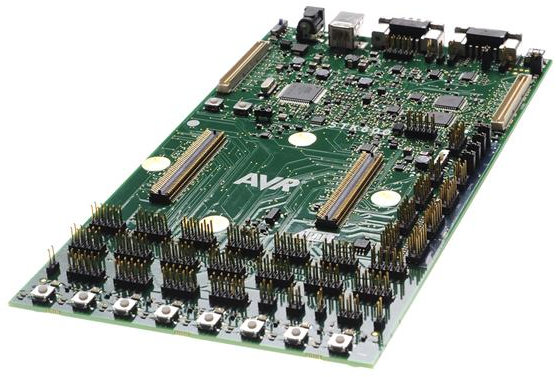Atmel announced 14 new Atmel AVR microcontrollers divided into 4 families: AVR XMEGA C, tinyAVR ATtiny1634, AVR UC3 L3 and AVR UC3 D4.
Atmel AVR XMEGA C MCUs
Atmel AVR XMEGA C MCUs are 8-/16-bit general-purpose MCUs with Full-Speed USB, 12-bit ADC, up to 384 KB flash and 32 KB SRAM. They can support Atmel QTouch Library for implementation of capacitive buttons, sliders and wheels functionality. The AVR XMEGA C MCUs consume 700nA in sleep mode with RTC.
There 8 new XMEGA C MCUs which target consumer, industrial and home automation applications such as thermostats with display, building and climate control, utility meters with RF and ZigBee connectivity.
The smallest XMEGA C MCU (ATxmega16C4), which comes in 44-pin package and has 16KB device, is the cheapest AVR XMEGA device with USB provided by Atmel.
You can find further information on Atmel AVR XMEGA C page.
Atmel tinyAVR ATtiny1634 MCU
Atmel tinyAVR ATtiny1634 MCU is a small-package, ultra-low power device with 1KB SRAM and 16 KB Flash featuring several digital interfacing options:
- 2 full-duplex universal synchronous/asynchronous receiver/transmitters (USARTs)
- A I2C slave interface
- A Serial peripheral interface (SPI) port
- A Universal Serial Interface (USI) that can work both as an I2C or a 3-wire interface.
This new device, which also support QTouch Library support, is aimed at interfacing and control in industrial and consumer applications such as household appliance control, man-machine interface (MMI) systems, and smart sensors and co-processors in industrial and communications applications.
You can find further information on Atmel tinyAVR ATtiny1634 page.
Atmel AVR UC3 L3 MCUs
Atmel AVR UC3 L3 MCUs feature up to 256KB , integrated USB controller, I2S support, audio bit-stream digital-to-analog converter (ABDAC) and an integrated QTouch hardware peripheral supporting up to 25 channels. The Atmel AVR UC3 L3 MCUs also have DSP instructions allowing designers to implement more advanced algorithms requiring more memory for consumer products. Atmel says those 3 new MCUs are ideal for sensors, capacitive touch remote controls and game pads, portable and battery-operated equipment, human interface devices, board controllers, industrial control systems, communication protocol translators and backlight LED units.
You can find further information on Atmel AVR UC3 L3 page.
Atmel AVR UC3 D4 MCUs
Atmel AVR UC3 D4MCUs come with 128KB Flash, 16KB SRAM, a hardware QTouch capacitive touch module, Full-Speed USB and several communication interfaces:
- 4 UARTs
- 4 SPI ports
- 2 two-wire interfaces (TWI)
- I2S.
Two new devices are available and target high data throughput applications in areas such as USB human interface, PC peripherals, biometrics, bridging and industrial control.
You can find further information on Atmel AVR UC3 D4 page.
Atmel AVR Software Development
Development on all Atmel AVR MCUs can be performed using Atmel Studio 6 IDE which help developers write, build and debug their applications written in C/C++ or assembly code. Atmel provides more than 1,100 project examples with source code (for ARM and AVR) which eliminate the need to develop low-level coding stuff. Those application and library examples are part of the Atmel Software Framework are composed of drivers, communication stacks, graphic services and touch libraries.

You can use ATMEL STK600 starter kit to develop software for AVR MCUs. You’ll also need the corresponding socket and routing cards for your chosen MCU(s), unless you use ATmega2560, as the MCU card is supposed to be included in the kit. Atmel AVR starter kit is available for 199 USD on Atmel Store as well as other distributors such as Newark/Element14.
Availability
Four devices in the AVR XMEGA C line (ATxmega384C3, ATxmega256C3, ATxmega192C3 and ATxmega384D3) are sampling now, while samples for the other 4 MCUs will be available in Q2 and Q3 2012. AVR UC3 L3, AVR UC3 D4 and AVR ATtiny1634 MCUs are already available for order with the exception of the ATTiny1634-UUR, which will be available in Q2 2012.

Jean-Luc started CNX Software in 2010 as a part-time endeavor, before quitting his job as a software engineering manager, and starting to write daily news, and reviews full time later in 2011.
Support CNX Software! Donate via cryptocurrencies, become a Patron on Patreon, or purchase goods on Amazon or Aliexpress






The six pin DIL chips in the top picture are not microcontrollers, I guess?
@ Sander
I blindly copied the picture on Atmel tinyAVR ATtiny1634 page http://www.atmel.com/devices/ATtiny1634.aspx without thinking about it. The new ATtiny1634 has 20 pins (so the picture does not really match the article), but some other tinyAVR MCU are available in 6-pin packages (e.g. ATtiny4, ATtiny10).
So the DIL chip above are most probably MCU, but just not one of the new ones.